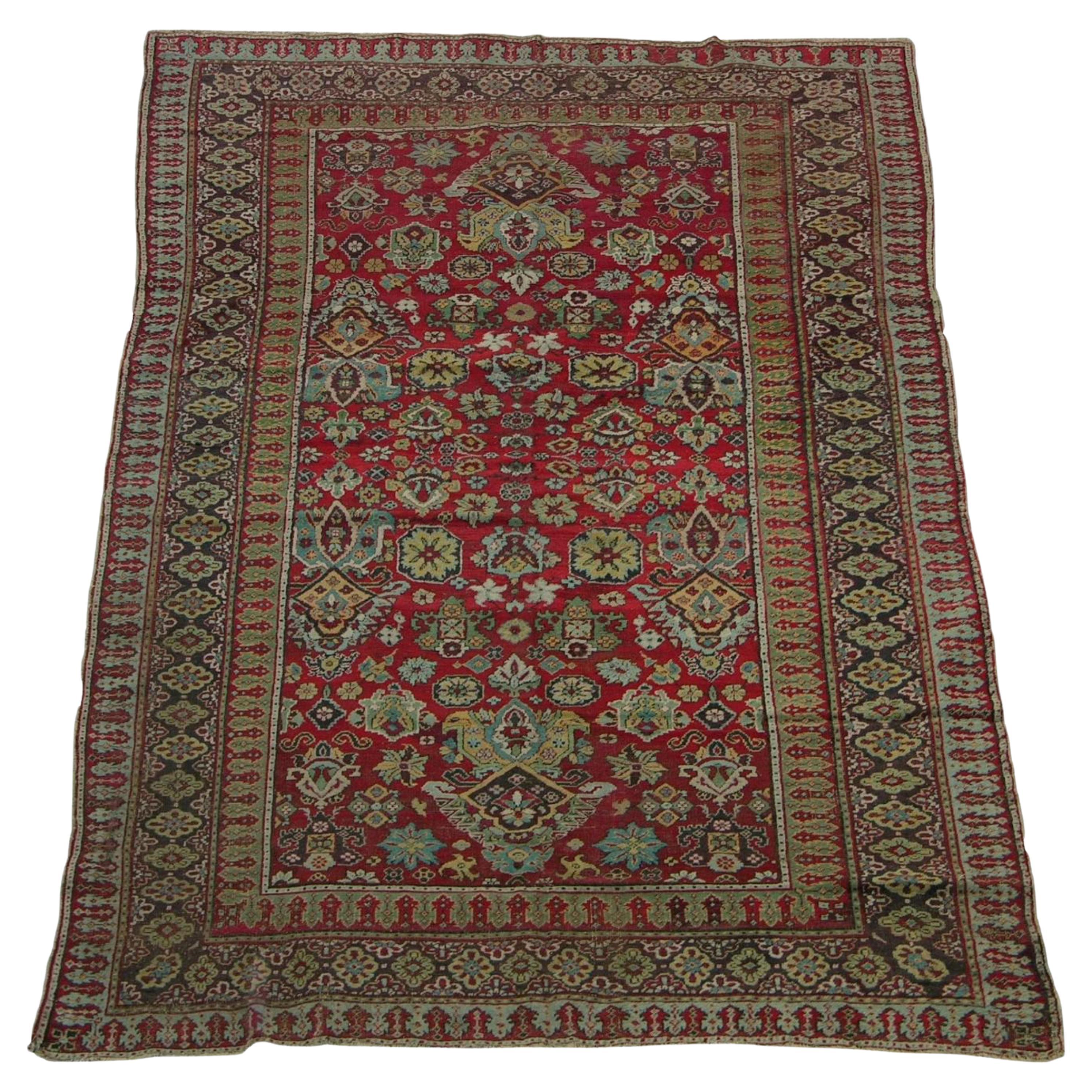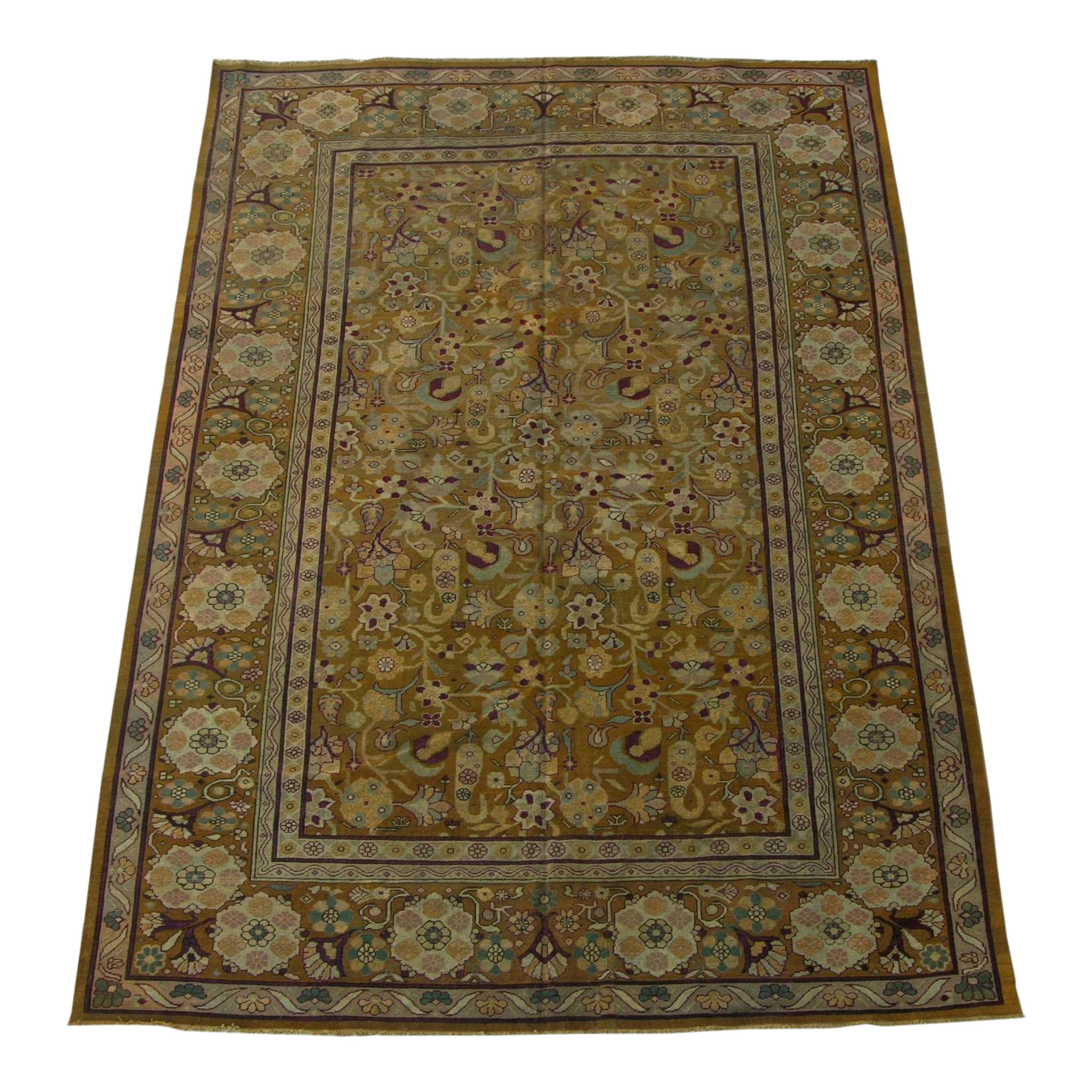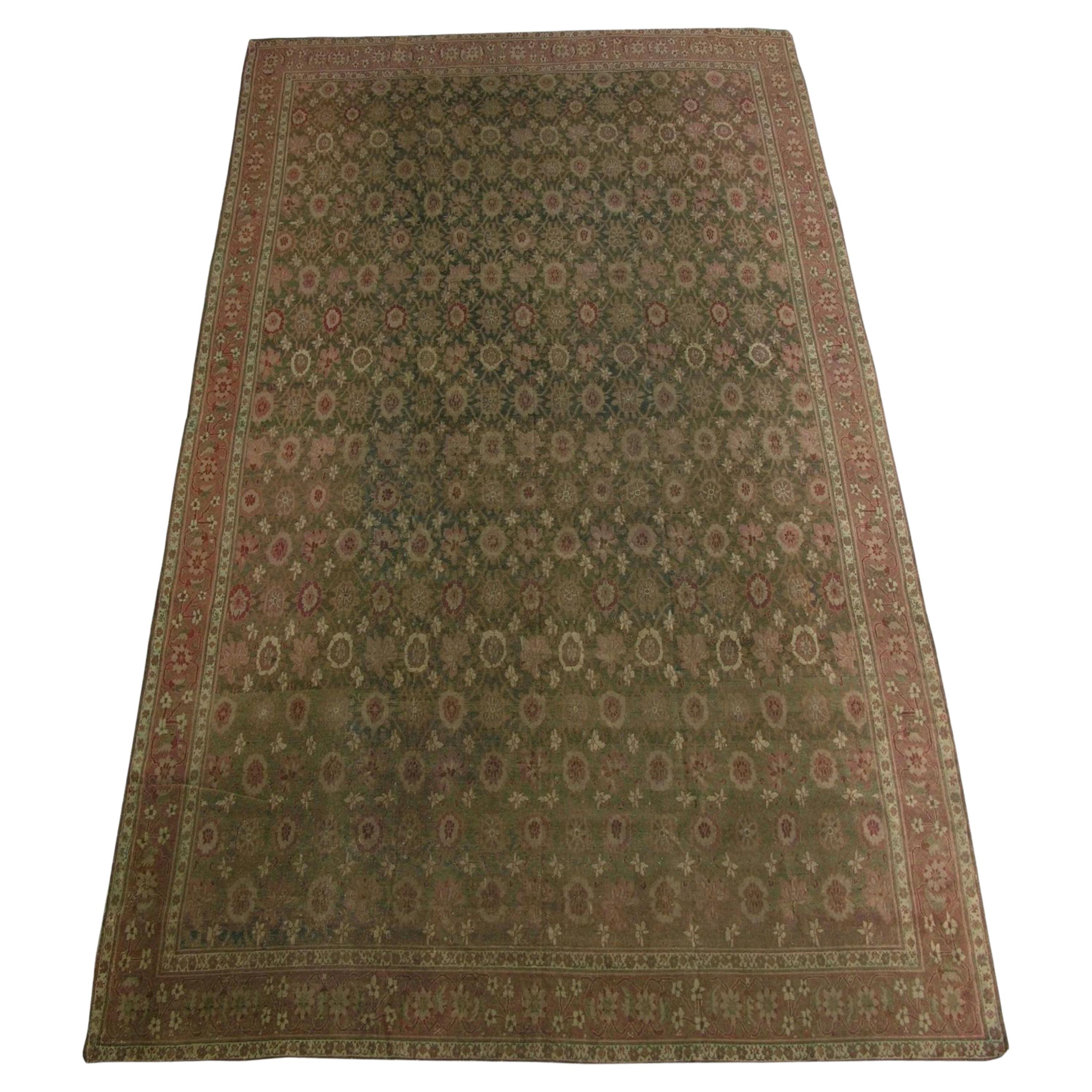Want more images or videos?
Request additional images or videos from the seller
1 of 5
1900s Antique Indian Amritsar Rug
About the Item
Antique Amritsar Rugs – The spectacular rugs of Amritsar capture the exotic style of India while incorporating a subtle colonial influence. This convergence of eastern and western styles results in an exceptionally alluring appearance that has been beloved by western consumers historically and today. The outstanding old Amritsar carpets were created by influential exporters to fuel the demand for exotic rugs and textiles following Queen Victoria’s 1851 Great Exhibition in the Crystal Palace. Elegant curvilinear botanical motifs and superior materials have made Amritsar carpets particularly desirable and easy to appreciate.
Amritsar carpets are extremely distinctive within the production of Indian carpets. Unlike the Agra Rugs, those produced in Amritsar, in the far north of India near Kashmir, do not represent a continuous production back to Mughal times. They seem to have resulted from a new nineteenth-century initiative under British rule. As such the Amritsar rug weavers were free to approach carpet design more on the basis of western needs than on their own traditions, so their carpets were from the outset well adapted to western decorative use. While their designs responded to contemporary Persian production, Amritsar rugs were generally made with a softer earthier palette, often with a tendency to burgundy or aubergine tones. To this day, they remain a superior decorative rugs by virtue of their flexible formal repertoire and coloration.
Amritsar is located in northwest India. Carpet production began in the late 19th and early 20th centuries during the rise of the British supremacy. Due to Western influence and European demand, the weavers were very prolific during this period. Designs appealed to Western tastes employing large-scale patterns featuring millefleur (thousands of flowers) motifs. A subtle color palate of light blues, yellow, teal and rust characterize these Indian rugs. Amritsar rugs often have cotton foundations, are double weft and use an asymmetrical knot. Very good quality wool is used resulting in a luxurious feel.
The popularity and influence of Amritsar rugs can be traced back to the British Empire’s Colonial rule in India. For the first time, in 1851, at the Great Exhibition in the Crystal Palace, Queen Victoria exposed the world, including laypeople, to the exotic look and feel of the Orient, and began the Western world’s love affair with purchasing “exotic” home furnishings.
The craftspeople of Northern India were quick to capitalize on this trend, making sure they could meet the demand for Amritsar rugs from wealthy people, especially in London, who considered it a status symbol to have beautiful, handcrafted Oriental rugs throughout their opulent homes.
Amritsar rugs were also a point of national pride for the English. For example, every time a Londoner displayed an Amritsar rug in his home, it was a reminder of the tremendous power and scope of the British Empire. National pride, in conjunction with all of the wealth that began pouring into the United Kingdom because from the sale of Oriental goods, were the main drivers in creating a large, highly-profitable market for Oriental artwork, in general.
Collectors in London, the United States, Canada, and other Western markets, were especially enamored by the elegant designs on Amritsar rugs, such as curved botanical motifs, and greatly appreciated the superior materials used in manufacturing these works of art. The soft, earthly palette of most Amritsar rugs, which featured burgundy or aubergine tones, complemented their other furnishings, making the rugs even more desirable.
Today, the Western world’s fascination with Oriental pieces of art – including Amritsar rugs – continues. The rugs remain highly desirable for collectors, mainly because of their flexibility to blend in with the color and style of elegant, modern homes throughout the world. Almost 200 years later, the unique styles of rugs that emerged in the nineteenth century in India are still widely regarded by art critics and historians, as some of the best designs ever created within the art and home furnishings industries
History of Amritsar:
Antique Amritsar Rugs – The spectacular rugs of Amritsar capture the exotic style of India while incorporating a subtle colonial influence. This convergence of eastern and western styles results in an exceptionally alluring appearance that has been beloved by western consumers historically and today. The outstanding old Amritsar carpets were created by influential exporters to fuel the demand for exotic rugs and textiles following Queen Victoria’s 1851 Great Exhibition in the Crystal Palace. Elegant curvilinear botanical motifs and superior materials have made Amritsar carpets particularly desirable and easy to appreciate.
Amritsar carpets are extremely distinctive within the production of Indian carpets. Unlike the Agra Rugs, those produced in Amritsar, in the far north of India near Kashmir, do not represent a continuous production back to Mughal times. They seem to have resulted from a new nineteenth-century initiative under British rule. As such the Amritsar rug weavers were free to approach carpet design more on the basis of western needs than on their own traditions, so their carpets were from the outset well adapted to western decorative use. While their designs responded to contemporary Persian production, Amritsar rugs were generally made with a softer earthier palette, often with a tendency to burgundy or aubergine tones. To this day, they remain a superior decorative rugs by virtue of their flexible formal repertoire and coloration.
Amritsar is located in northwest India. Carpet production began in the late 19th and early 20th centuries during the rise of the British supremacy. Due to Western influence and European demand, the weavers were very prolific during this period. Designs appealed to Western tastes employing large-scale patterns featuring millefleur (thousands of flowers) motifs. A subtle color palate of light blues, yellow, teal and rust characterize these Indian rugs. Amritsar rugs often have cotton foundations, are double weft and use an asymmetrical knot. Very good quality wool is used resulting in a luxurious feel.
The popularity and influence of Amritsar rugs can be traced back to the British Empire’s Colonial rule in India. For the first time, in 1851, at the Great Exhibition in the Crystal Palace, Queen Victoria exposed the world, including laypeople, to the exotic look and feel of the Orient, and began the Western world’s love affair with purchasing “exotic” home furnishings.
The craftspeople of Northern India were quick to capitalize on this trend, making sure they could meet the demand for Amritsar rugs from wealthy people, especially in London, who considered it a status symbol to have beautiful, handcrafted Oriental rugs throughout their opulent homes.
Amritsar rugs were also a point of national pride for the English. For example, every time a Londoner displayed an Amritsar rug in his home, it was a reminder of the tremendous power and scope of the British Empire. National pride, in conjunction with all of the wealth that began pouring into the United Kingdom because from the sale of Oriental goods, were the main drivers in creating a large, highly-profitable market for Oriental artwork, in general.
Collectors in London, the United States, Canada, and other Western markets, were especially enamored by the elegant designs on Amritsar rugs, such as curved botanical motifs, and greatly appreciated the superior materials used in manufacturing these works of art. The soft, earthly palette of most Amritsar rugs, which featured burgundy or aubergine tones, complemented their other furnishings, making the rugs even more desirable.
Today, the Western world’s fascination with Oriental pieces of art – including Amritsar rugs – continues. The rugs remain highly desirable for collectors, mainly because of their flexibility to blend in with the color and style of elegant, modern homes throughout the world. Almost 200 years later, the unique styles of rugs that emerged in the nineteenth century in India are still widely regarded by art critics and historians, as some of the best designs ever created within the art and home furnishings industries.
- Dimensions:Width: 115 in (292.1 cm)Length: 118 in (299.72 cm)
- Style:Other (In the Style Of)
- Materials and Techniques:
- Place of Origin:
- Period:1900-1909
- Date of Manufacture:1900
- Condition:Great Condition.
- Seller Location:Los Angeles, US
- Reference Number:
About the Seller
5.0
Gold Seller
These expertly vetted sellers are highly rated and consistently exceed customer expectations.
Established in 1920
1stDibs seller since 2023
26 sales on 1stDibs
Typical response time: <1 hour
- ShippingRetrieving quote...Ships From: Los Angeles, US
- Return PolicyA return for this item may be initiated within 3 days of delivery.
More From This SellerView All
- 1900s Antique Indian Amritsar RugLocated in Los Angeles, USAntique Amritsar Rugs: - The spectacular rugs of Amritsar capture the exotic style of India while incorporating a subtle colonial influence. This convergence of eastern and western s...Category
Antique Early 1900s Asian Other Russian and Scandinavian Rugs
MaterialsWool, Cotton
- 1900s Antique Fine Indian Purple Amritsar RugLocated in Los Angeles, USAntique Amritsar Rugs – The spectacular rugs of Amritsar capture the exotic style of India while incorporating a subtle colonial influence. This convergence of eastern and western st...Category
Antique Early 1900s Asian Other Russian and Scandinavian Rugs
MaterialsWool, Cotton
- 1900s Antique Indian Amritsar RugLocated in Los Angeles, USDuring the period of Colonial rule over India, Amritsar rugs began to reflect Western influences in their design. The craftspeople of Northern India took their chance to profit from ...Category
Antique Early 1900s Indian Other Indian Rugs
MaterialsWool, Cotton
- Antique Indian Amritsar Rug - 16'0'' X 9'0''Located in Los Angeles, USDuring the period of Colonial rule over India, Amritsar rugs began to reflect Western influences in their design. The craftspeople of Northern India took their chance to profit from ...Category
Antique Early 1900s Asian Other Russian and Scandinavian Rugs
MaterialsWool, Cotton
- 1900s Antique Indian Amritsar RugLocated in Los Angeles, USDuring the period of Colonial rule over India, Amritsar rugs began to reflect Western influences in their design. The craftspeople of Northern India took their chance to profit from ...Category
Antique Early 1900s Indian Tribal Indian Rugs
MaterialsWool, Cotton
- Antique Indian Amritsar Rug with Floral DesignLocated in Los Angeles, USAntique Amritsar Rugs – The spectacular rugs of Amritsar capture the exotic style of India while incorporating a subtle colonial influence. This convergence of eastern and western st...Category
Antique Early 1900s Asian Other Russian and Scandinavian Rugs
MaterialsWool, Cotton
You May Also Like
- Handmade Antique Caucasian Avar Rug, 1900s, 1p49Located in Bordeaux, FRHandmade antique Caucasian Avar rug from Daghetsan. The rug is in unusual design, from the beginning of 20th century. -condition: good, -circa: 1900s, ...Category
Antique Early 1900s Russian Russian and Scandinavian Rugs
MaterialsWool
- Antique Hand Woven Russian Besserabian Rug, circa 1900sLocated in New York, NYThis southern Russian kilim-tapestry technique carpet shows a golden-tan field with a three echelon pattern of outline cartouches and barbed leaf-forms detailed in sienna, cream and ...Category
Antique Early 1900s Russian Bessarabian Russian and Scandinavian Rugs
MaterialsWool
- Handmade Antique Indian Amritsar Oriental Rug, 1900s, 1B147Located in Bordeaux, FRAntique Indian Amritsar rug in burgundy and beige shades. The true masterpiece of its kind with all over design and detailed floral style.Category
Early 20th Century Indian Indian Rugs
MaterialsWool
- 1900s Indian Amritsar Botanic Handmade Wool RugLocated in New York, NY1900s Indian Amritsar botanic handmade wool rug Size: 11'9" x 15'8" (358 x 477 cm) While India does in fact boast a long history of weaving, Amritsar rugs are unique in the wide gamu...Category
Early 20th Century Indian Indian Rugs
MaterialsWool
- Antique Russian Chichi, circa 1900sLocated in WEST HOLLYWOOD, CARug Number 17218 Size 3' 5" X 6' 2" Design Chichi Collection Antique/Vintage Material Wool Texture Pile Weave Origin Russia Age Antique/Vintage.Category
Antique Early 1900s Russian Russian and Scandinavian Rugs
MaterialsWool
- Antique Russian Gharabagh Circa 1900sLocated in WEST HOLLYWOOD, CARug Number 28430 Size 3' 8" X 5' 7" Design Gharabagh Collection Antique/Vintage Material Wool Texture Pile Weave Origin Russia Age Antique/VintageCategory
Antique Early 1900s Russian Russian and Scandinavian Rugs
MaterialsWool





